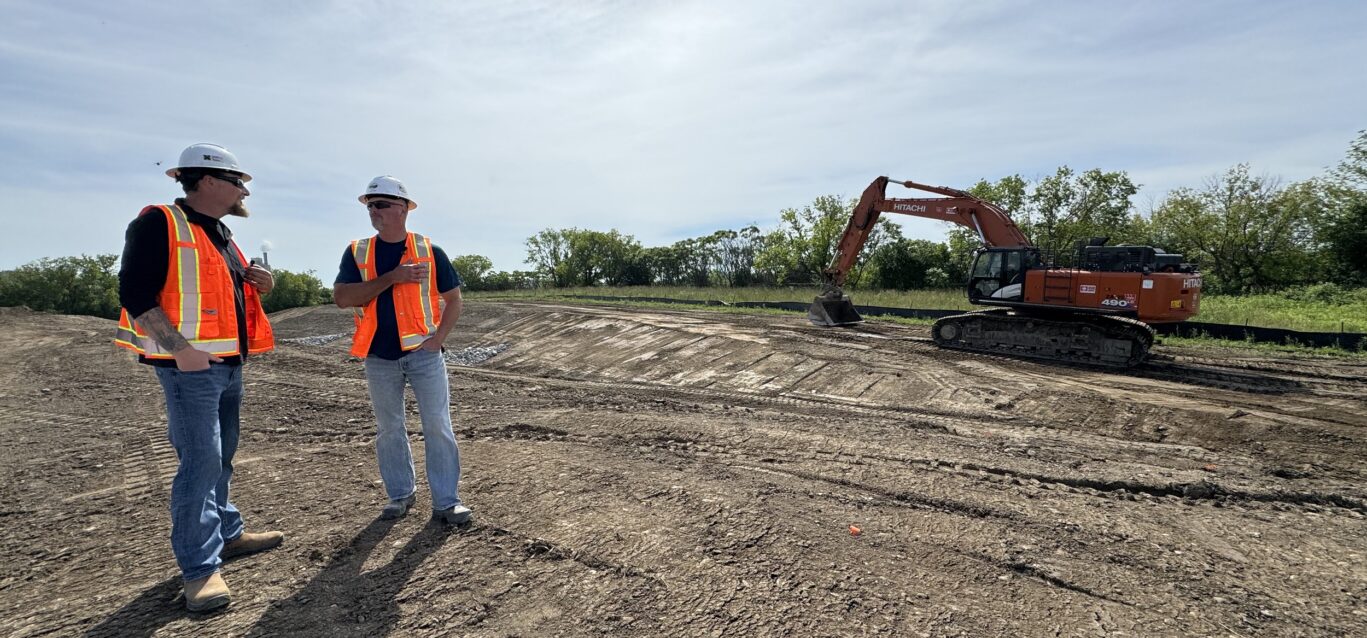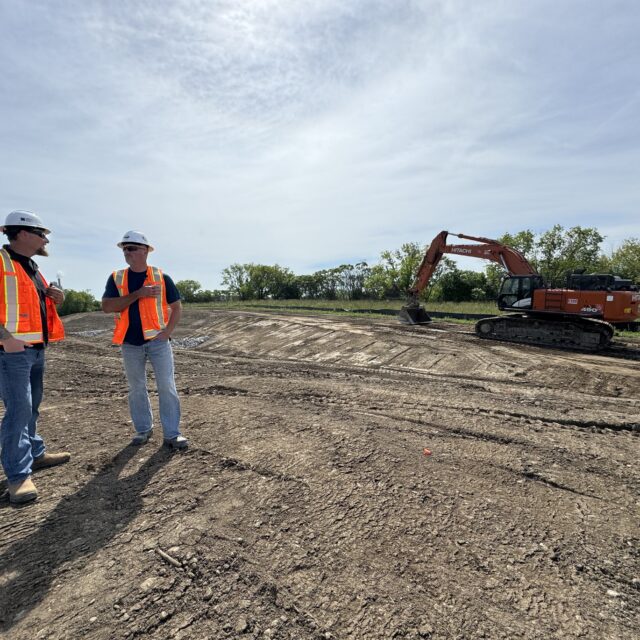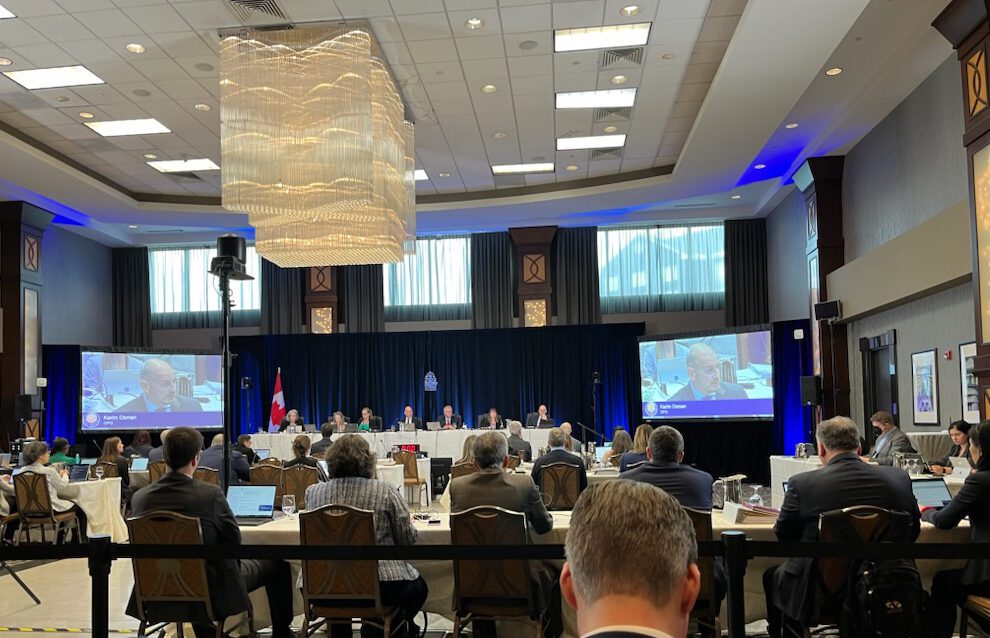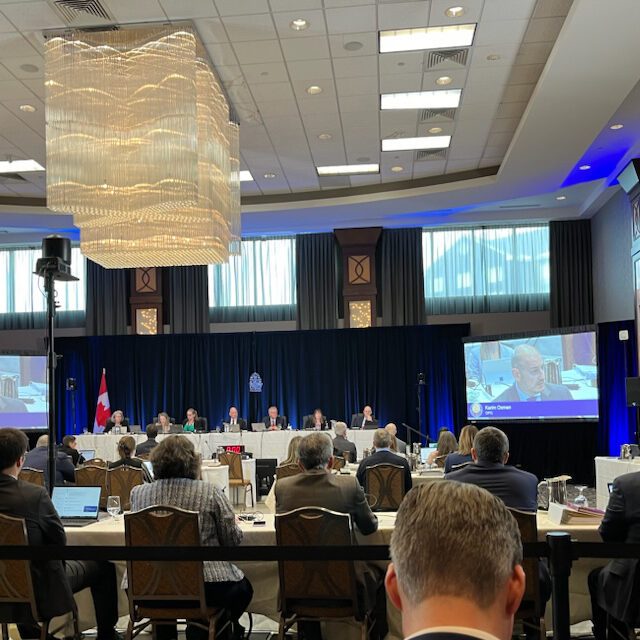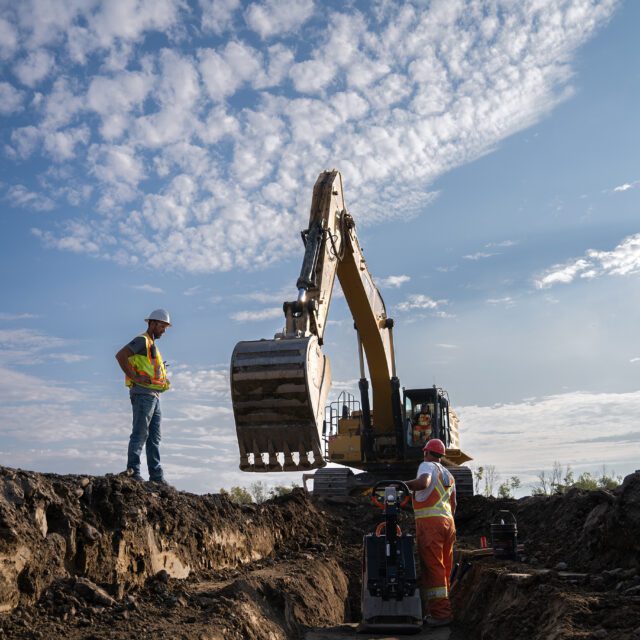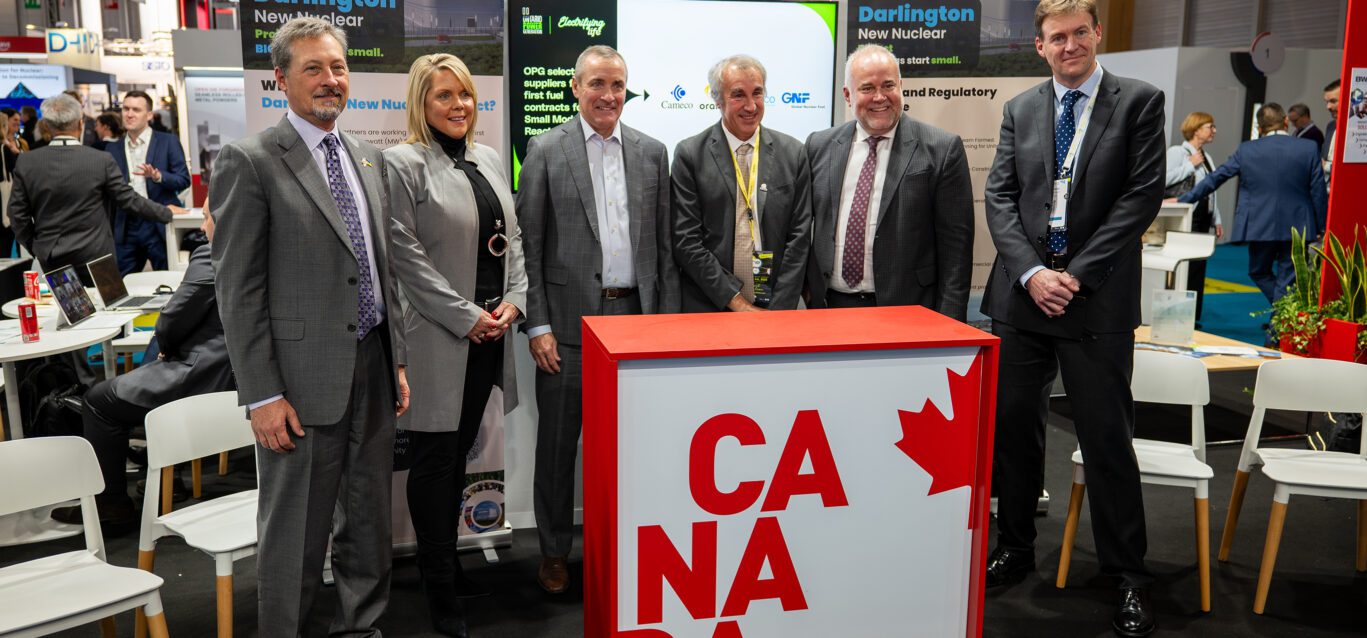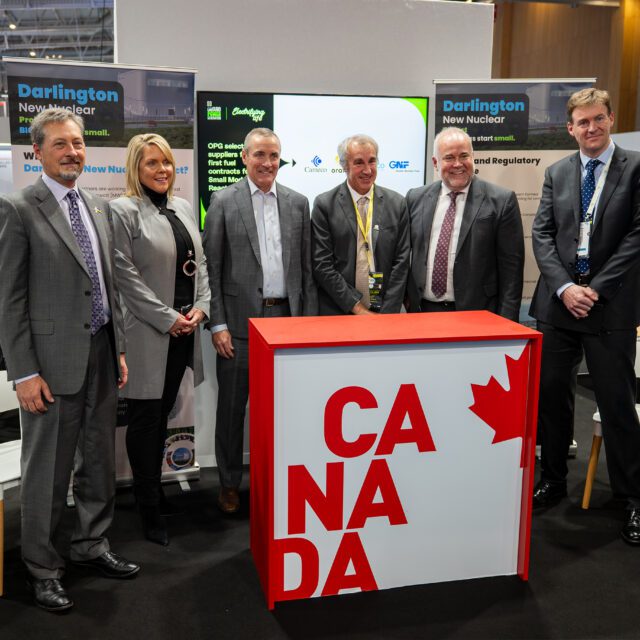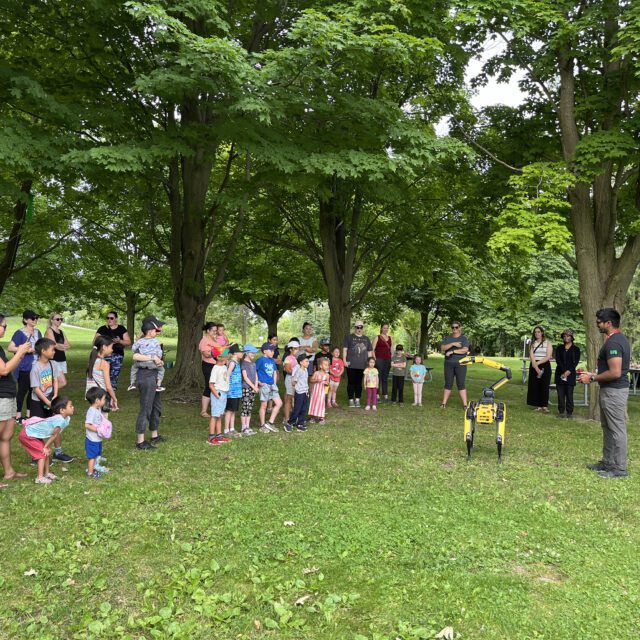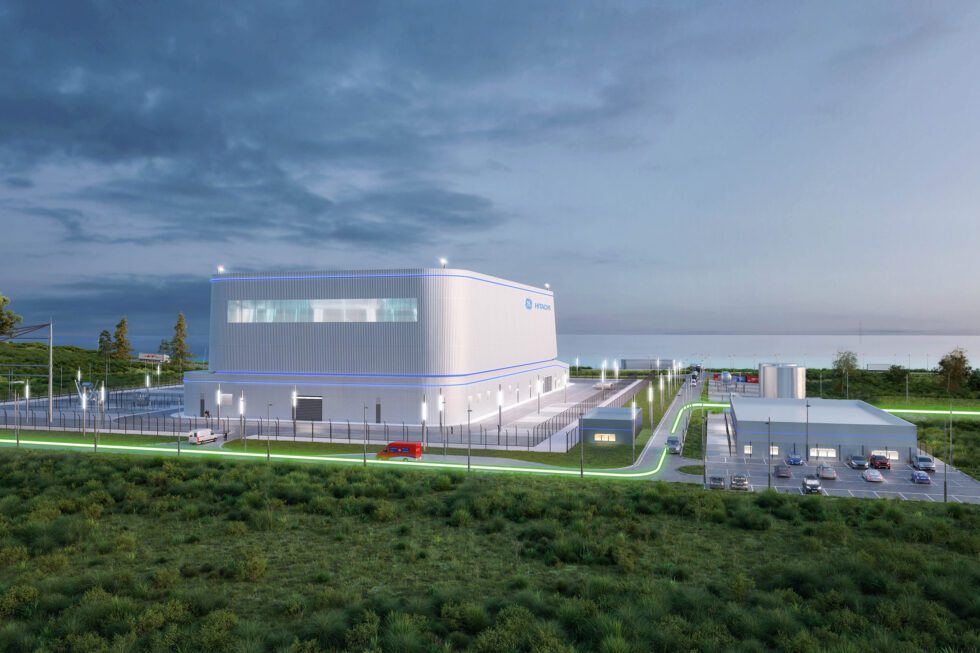- Voyageur paves the way for First Nations
- DNNP EA confirmed applicable to BWRX-300
- Early site preparation work complete
- OPG selects fuel suppliers for SMRs
Upcoming events

The Darlington New Nuclear Project is leading the way in the advancement of Small Modular Reactor (SMR) technology in Canada – the future of nuclear power generation.
On July 7, 2023, the Ontario government announced it will work with Ontario Power Generation (OPG) to commence planning and licensing for three additional SMRs, for a total of four SMRs at the Darlington new nuclear site. Pending regulatory approvals to build three additional units, the total output of the Darlington New Nuclear Project would be 1,200 megawatts; enough electricity to reliably and safely power about 1.2 million homes, and help our community and the Province meet increasing demand from electrification.
Site preparation progress – Summer 2024
Work on the tunnel boring machine launch shaft retaining wall was recently completed; a significant milestone for the condenser cooling water project. The team is now drilling for the reactor building shaft retaining wall. Pre-requisite activities for Units 2-4 site preparation work were also recently completed, with grading works for future units expected to commence in late summer.
Work on the fabrication and pre-assembly buildings has begun. Site grading for the fabrication shop is complete and excavation and backfill of the building footprint is being finalized. Soon, concrete teams will begin work on building foundations. The on-site fabrication building will transform materials shipped to the site into finished components ready for installation. Finished components will move from the fabrication building into the pre-assembly building, to undergo final assembly and be integrated into larger systems. These buildings are critical links in our supply chain, ensuring the production of components that meet the highest standards of safety, reliability and regulatory compliance.
Licence to construct documentation
OPG has applied to the Canadian Nuclear Safety Commission (CNSC) for a Licence to Construct its first SMR unit at the Darlington site. The CNSC has announced a two-part public hearing will take place virtually in October 2024 and in-person (with a virtual option) in January 2025 at the Ajax Convention Centre. The public hearing process includes the opportunity for Indigenous Nations and Communities and the public who have interest, expertise or information that may be useful to the Commission to comment on OPG’s application. More details on the hearing and the process for participation can be found on the CNSC website. Interventions are encouraged and due to the CNSC by Nov. 4, 2024.
For other documents related to the project, please see supporting documents and resources.
New nuclear project facts
~1.2
million homes could be powered by four 300 MWe SMRs
2,000
jobs could be sustained each year over the 60-year lifetime of a fleet of four SMRs
$13.7 billion
contributed to Ontario’s GDP through construction & operation of four SMRs
Questions & Answers
Why do we need these SMRs in Ontario?
SMRs are a flexible, scalable nuclear solution. They can address climate change by helping Ontario manage the increased electricity demand that begins to emerge in the middle of this decade, due primarily to the electrification of the transportation sector and other currently high-emitting sectors.
A fleet of four grid-scale SMRs in Ontario will also pave the way for the deployment of this technology elsewhere in Canada and abroad, particularly in those jurisdictions seeking to replace their coal-powered plants with carbon-free sources.
Nuclear is a proven carbon-free energy source. Canada will need to harness all clean energy technologies to achieve its climate change objectives and net-zero by 2050. Nuclear provides the clean, reliable baseload power necessary to meet increasing electricity demands.
SMR technologies are critical to this approach and represent significant potential for Canadian leadership.
The evidence is clear, as stated by experts like the International Atomic Energy Agency - without nuclear, there is no path to bringing the world’s carbon emissions to net-zero by 2050.
What will the project cost?
An August 2023 Conference Board of Canada study concluded that the construction and operation and maintenance of four new nuclear Small Modular Reactor (SMR) plants will have a significant economic impact on the Ontarian and Canadian economy.
Specifically, economic benefits are four times better with four SMRs than with one, and four SMRs at Darlington are expected to:
- increase Canadian GDP $15.3 billion over 65 years; and
- sustain, on average, approximately 2,000 jobs per year – over 65 years.
This corresponds to a nearly $3.8 billion increase in GDP and 500 jobs per year over the same time period per SMR.
The economic impact, or the ratio of increased GDP to spending (the “economic multiplier") is 0.82 – each dollar spent would increase Canadian GDP by $0.82 across the total lifespan of the technologies.
What’s the climate benefit?
Nuclear power is the backbone of Ontario’s electricity system and provides affordable and reliable energy 24/7 – avoiding 45 million tonnes of CO2 emissions each year.
In Canada alone, nuclear power helps avoid carbon emissions each year the equivalent of removing 15 million cars from the road.
A single SMR of about 300 Megawatts electric (MWe) in size can prevent between 0.3 megatonnes (MT) to 2 MT of CO2 emissions per year depending where it is located and what kind of power it is displacing.
Nuclear is also the right choice from a land-use perspective: to generate the same amount of energy as nuclear, solar would require about 100 times and wind about 500 times more land area.
Why not build another CANDU reactor like the existing Darlington units?
OPG has invested, and continues to invest, in the Darlington Refurbishment project, and as announced in January 2024, Pickering now has the opportunity to continue producing safe, reliable energy for Ontario by delivering another world-class refurbishment project for the benefit of generations to come. CANDU technology forms the backbone of our nuclear generating fleet, and will continue to do so for decades to come.
When will the SMRs start producing power?
Our planning goal is to complete construction of the first SMR by end of 2028, and be commercially available by the end of 2029.
Similar to how we’ve planned and executed our on-time, on-budget Darlington Refurbishment Project, timing of construction of subsequent units will be staged to ensure we can apply learnings from the first unit’s construction to deliver cost and time savings on subsequent units. Additional regulatory approvals will be required prior to construction and operation of additional units.
Why don’t we just import power from elsewhere?
Importing electricity from neighbouring jurisdictions is important for the reliability of the grid. But, it is not possible to rely solely on imports to solve the baseload capacity needed to meet Ontario’s year-round energy needs emerging in the middle of this decade, nor will relying heavily on imports support Ontario’s economic and environmental objectives to build out new clean energy infrastructure here in Ontario.
As well, every neighbouring jurisdiction to Ontario will be facing increased demand for electricity at the same time as we do, which would impact prices and reliability.
Some options for importing power simply don’t have as clean a grid as Ontario, which could mean power produced by coal and other fuels producing more GHGs than Ontario, undermining our work to have electricity help efficiently decarbonize the broader economy, as promised in our Climate Change Plan.
Is Ontario the only province looking at building SMRs?
No. The governments of Ontario, New Brunswick, Saskatchewan, and Alberta have signed a Memorandum of Understanding to collaborate to advance SMRs as a clean energy option to address climate change and regional energy demands, while supporting economic growth and innovation.
The SMR Feasibility Study, formally requested as part of the MOU in December 2019, concludes that the development of SMRs would support domestic energy needs, curb greenhouse gas emissions, and position Canada as a global leader in this emerging technology.
Now, the four provinces have agreed to a joint strategic plan outlining the path forward on SMRs. The plan builds on the SMR Feasibility Study by identifying provincial strategies for SMR deployment, including actions to enable decision making and actions following potential provincial decisions to proceed.
Why should Ontario go first?
Ontario has a long history of safe, reliable nuclear power generation.
The province is also home to an extensive nuclear supply chain, which has recently been rejuvenated and recapitalized by refurbishment of existing nuclear generation facilities, including Darlington.
A 2019 study for the Canadian Nuclear Association and Organization of Canadian Nuclear Industries shows the nuclear industry contributes $17 billion per year to the Canadian GDP and supports about 76,000 jobs in Canada.
Not only that, but the Darlington site is the only site in Canada currently licensed for new nuclear build with an accepted environmental assessment.
Going first will benefit all Ontarians and cement Durham Region’s position as the clean energy capital of Ontario.
Acting as a first mover of SMR technology is a significant global leadership opportunity for Ontario and Canada. It will allow us to capture first-mover benefits and export market opportunities. It is likely companies involved in the first deployment will have opportunities elsewhere in Canada and abroad as use of SMRs grows.
How did you decide which technology partner to work with?
OPG conducted an extensive review process, starting in 2018, to examine the many different SMR technologies within the nuclear industry.
In 2020, we underwent a Due Diligence process, which included a deep dive into certain SMR technologies. From there, OPG developed a list of three developers who possessed technology we felt satisfied our environmental assessment commitments and could achieve our goal to have an SMR commercially available in 2029.
Each technology was assessed against a number of key areas, such as: safety, technological readiness, licensability at our Darlington site, environmental impact, economic development potential, and cost.
In December 2021, OPG announced we were partnering with reactor technology developer, GE Hitachi Nuclear Energy (GEH). OPG is confident GEH’s BWRX-300 reactor technology is best positioned to provide a new source of carbon-free nuclear energy for Ontario’s future projected energy and capacity demand, and to support the potential for deployment of SMRs to other Canadian jurisdictions interested in reducing fossil fuel use.
Will there be an impact to the Darlington Waterfront Trail?
OPG’s Darlington New Nuclear team continues to progress site preparation activities, including construction of a roadway on the eastern portion of the Darlington Nuclear site. To prioritize the safety of users, the trail has been diverted away from the construction work and rerouted along Energy Drive. Access to the trail remains available on this rerouted path (see image below). The portion of the Waterfront Trail west of Holt Rd. will not be impacted. OPG will seek to re-establish full access to the Waterfront Trail in stages, once it is safe to do so.
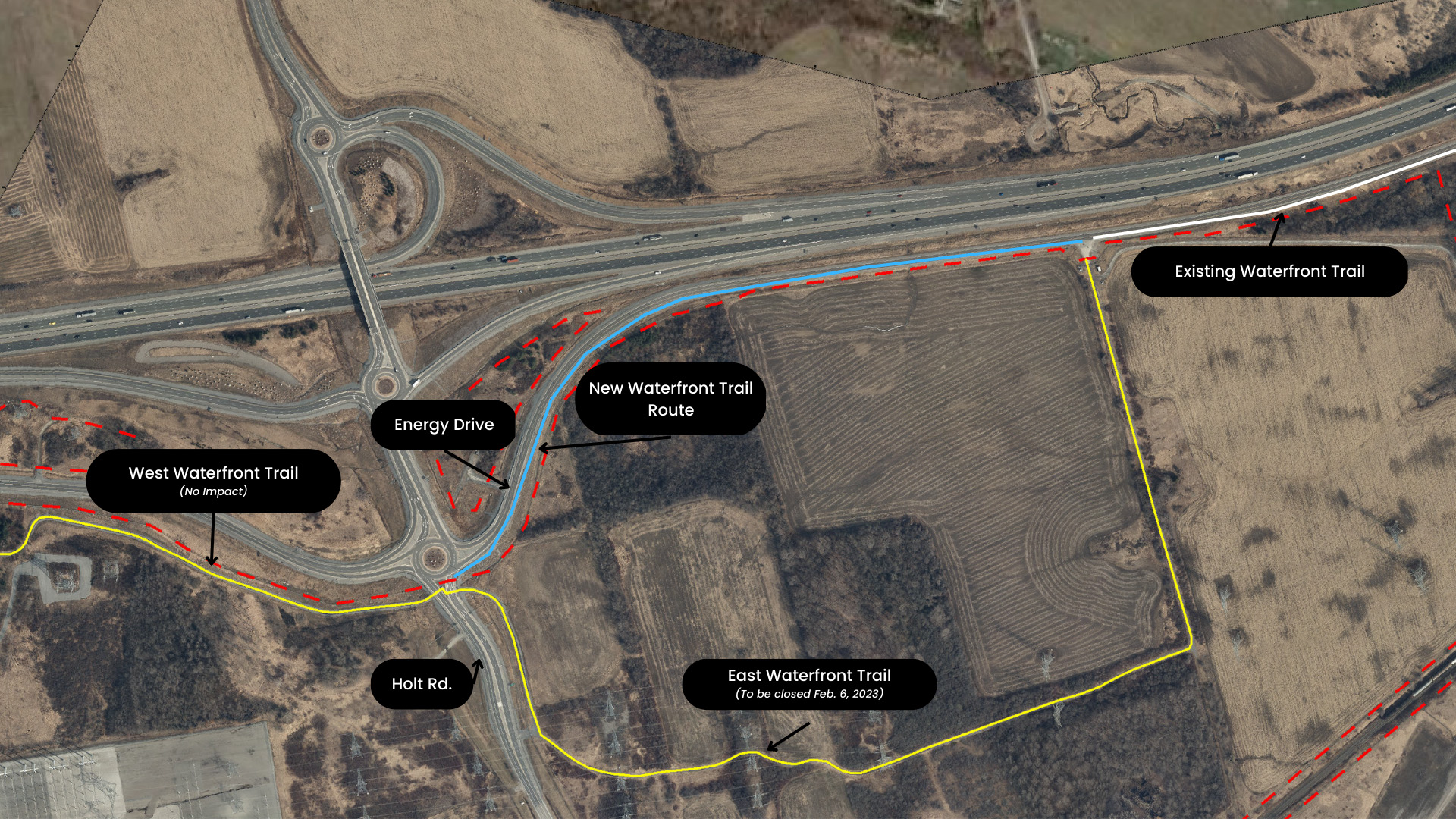

How do I become a supplier for the project?
We have a very strong nuclear supply chain in Ontario that serves our current plants, and we want to leverage that Canadian quality and know-how to increase the economic potential for Ontario and Canada. Throughout the development of the DNNP, we will continue to reinforce Canadian content requirements to ensure the Canadian supply chain will be maximized to the extent possible in design, construction, and operational support. Potential suppliers and contractors can connect with the DNNP Procurement Team through the Contact Us form below.
Will building three additional SMRs impact the plans for the first unit?
Our team remains focused on delivering the first SMR unit safely, on time, and on budget. In fact, it is the success our project team has experienced on the work done for Unit 1 thus far that has given our shareholder the confidence to move forward with additional units. As we’ve learned from our Darlington Refurbishment project, success on our first unit will pave the way for success on subsequent units, which is why we are prioritizing getting the first one right.
Is there a benefit to taking a fleet approach to your SMR program?
Taking a “fleet” approach will reduce project costs by sharing common infrastructure like cooling water intake, across four units. Due to the modular nature of manufacturing these units, once one is designed and built, subsequent units will be more easily replicable, driving down cost and construction time.
In addition, building four SMRs at Darlington is a real opportunity to cement Ontario’s nuclear supply chain as the supplier of clean energy technology to the world, which means more high-quality jobs in Durham Region and across Ontario.
Will construction activities be visible to the community?
During the site preparation and construction phases of the project, the public may notice the soil pile adjacent to the eastbound lanes of the 401 at Holt Road continuing to grow. Clean soil, native to the site, is being excavated and relocated from the southern portion of the Darlington Nuclear site, to the northern border, in order to level out the lands where future SMRs are intended to be situated.
Similar to the existing berm located further west of the site, the end state of the soil pile will be a permanent soil structure that would be seeded and planted to blend with the surrounding landscape.
DNNP Chronology
- Chronology of activities and events
Click on 🛈 below to read more information on milestones and related documents.
- The Government of Ontario, OPG’s shareholder, directs OPG to initiate the federal approvals process for new nuclear generating units in response to recommendations from the Ontario Power Authority’s Integrated Power System Plan.
- The Plan calls for investment in new nuclear generation capacity in order to maintain Ontario’s nuclear generating capacity at 14000 MWe, consistent with nuclear energy’s share of the 2005 supply mix.
- As required by the Canadian Environmental Assessment Act (1992), an Environmental Assessment (EA) of the proposed project is conducted, including comprehensive studies undertaken by OPG and consultation with Indigenous communities, local community members and the broader public.
- A Joint Review Panel consisting of representatives from the Canadian Nuclear Safety Commission (CNSC) and Canadian Environmental Assessment Agency, conducts a 17-day public hearing to consider OPG’s Environmental Impact Statement and licence application.
- Members of the public, Indigenous communities and various organizations and agencies present oral and written submissions.
- The Joint Review Panel submits their Environmental Assessment report to the Federal Minister of Environment, recommending that the EA be accepted.
- The Government of Canada issues a response accepting the recommendation of the Joint Review Panel and accepting the Environmental Assessment (EA).
- The CNSC issues the Licence to Prepare Site to OPG for a period of 10 years, valid from August 17, 2012 to August 17, 2022.
- Citing lower than planned power consumption growth combined with a strong supply situation, the Government of Ontario, through the 2013 Long-Term Energy Plan, requests that OPG defer the construction of new nuclear reactors but maintain the existing licence.
- OPG continues to maintain the licence in accordance with the licence conditions.
- OPG submits a licence Mid-Term report to the CNSC, outlining the activities undertaken since the licence was granted as well as a report providing an update on the commitments made by OPG (updated April 2019) during the licencing process.
- OPG issues notification to the CNSC of our intent to apply to renew the site licence that is set to expire in August 2022.
OPG has submitted an application to the Canadian Nuclear Safety Commission (CNSC) seeking renewal of the licence that allows OPG to undertake site preparation activities required for new nuclear generation at OPG’s Darlington site.
OPG currently holds a Site Preparation Licence for the Darlington Nuclear site, the first of a series of licences that would be required for additional nuclear generation capacity. The current 10-year licence was obtained following the completion of comprehensive environmental impact studies and an extensive public hearing conducted by a Joint Review Panel of the CNSC and the Canadian Environmental Assessment Agency in 2012.
OPG has not yet undertaken any licensed activities on the site. However, the existing licence allows OPG to carry out activities to prepare the site for future construction, for example:
- Clearing and grubbing vegetation
- Excavation and grading of site
- Installing services and utilities required to service the future project facilities (e.g., domestic water, fire water, sewage, electrical, communications, natural gas)
- Constructing support buildings
As the licence expires in 2022, renewing the licence will help maintain the option for reliable, low carbon nuclear energy to remain a key part of Ontario’s low-emission energy mix.
With the application submitted, the CNSC will determine the timing and process for review. A decision by the commission members is expected in 2021. The application and supporting documents are available here:
- The CNSC has issued a Notice of Public Hearing and Participant Funding for OPG’s application to renew the DNNP Site Preparation Licence
- On Nov. 13, 2020, OPG was joined by Provincial government and local municipal and business leaders to announce that planning activities will resume to construct a Small Modular Reactor at OPG’s Darlington site in Clarington.
- The CNSC held a two-day virtual hearing to consider OPG’s application to renew its Site Preparation Licence for the Darlington site.
- The CNSC issued the Licence to Prepare Site renewal to OPG for a period of 10 years, valid from October 12, 2021 until October 11, 2031.
On Dec. 2, 2021, OPG was joined by the Minister of Energy, and local elected officials and business leaders to announce it will work together with GE Hitachi Nuclear Energy to deploy a Small Modular Reactor (SMR) at the Darlington new nuclear site, the only site in Canada currently licensed for a new nuclear build.
On Mar. 10, 2022, OPG was joined by the Minister of Energy and local elected officials and business leaders to announce a contract award to E.S. Fox to perform the early site preparation work required for future construction of the company’s first grid-scale small modular reactor.
On June 8, 2022 the Canadian Nuclear Safety Commission announced its approval of OPG’s application for acceptance of the Financial Guarantee for the site preparation phase of the Darlington New Nuclear Project. This milestone opens the door for site preparation work to begin.
OPG has received regulatory approval to enter into the next phase of project development – site preparation.
This work includes non-nuclear infrastructure activities, such as clearing and grading a portion of the new nuclear site to build roads, utilities and support buildings. Mobilization for these activities begins in late September 2022, with execution of site preparation work planned to continue into 2025.
A Licence to Construct from the CNSC is required before any construction work on an SMR at Darlington can begin. OPG’s application for this licence is comprised of a number of packages, submitted to the CNSC over the course of several months. This application process will culminate in a public hearing where the regulator will hear comments from members of the public regarding our application.
OPG partnered with GE Hitachi Nuclear Energy (GEH), SNC-Lavalin, and Aecon to plan, construct, and deploy an SMR at the Darlington site.
All parties will manage the project as an integrated team and each company will play a specific role in successfully completing the Darlington New Nuclear Project:
- OPG: The license holder; OPG will maintain overall responsibility for the project, including operator training, commissioning, Indigenous engagement, stakeholder outreach and oversight.
- GE Hitachi: The technology developer; responsible for design, procurement of major components, and engineering and support.
- SNC-Lavalin: The architect engineer; provides design, engineering and procurement support.
- Aecon: The constructor; will provide construction planning and execution.
On July 7, 2023, the Ontario government announced it will work with OPG to commence planning and licensing for three additional SMRs, for a total of four, at the Darlington new nuclear site.
Ontario Power Generation (OPG) announced it is partnering with companies from Canada, the U.S., and France to ensure a fuel supply for the first unit of its four-unit Darlington New Nuclear Project.
The four contracts will involve:
- Canadian company, Cameco, which has uranium mines in Saskatchewan and a Uranium Hexafluoride (UF6) conversion facility in Port Hope, will supply natural UF6.
- US-based, Urenco USA (UUSA) will provide uranium enrichment services from their operations in Eunice, New Mexico.
- France’s Orano will provide additional Enriched Uranium Product (EUP) from their operations in France.
- And US-based, Global Nuclear Fuel-Americas LLC, a GE-led joint venture, will provide fuel fabrication and related technical services and fuel assemblies.
The CNSC held a three-day hybrid hearing to consider the applicability of the DNNP environmental assessment and plant parameter envelope to OPG’s selected BWRX-300 small modular reactor technology
On Feb. 15, 2024, OPG and site preparation partner, E.S. Fox, turned the Darlington New Nuclear Site over to construction partner, Aecon, following on-schedule completion of the early site preparation work program. The work completed under the Site Preparation Licence over the past two years included site clearing and grading, construction of temporary roads and laydown areas, and installation of stormwater features, as well as establishing on-site utilities. Aecon will now undertake the main site preparation work program which will include installation of permanent construction power, clearing and grubbing for a four-unit layout, construction work for site establishment activities including the shoring wall required for reactor building excavation, and construction of fabrication and administration buildings.
On April 22, 2024, the Canadian Nuclear Safety Commission (CNSC) announced the Commission’s decision that the existing environmental assessment for the Darlington New Nuclear Project is applicable to GE Hitachi’s BWRX-300 small modular reactor technology.
- The Licence to Construct process includes opportunities for Indigenous Nations and communities and the public to discuss the application, ask questions and raise areas of interest.
- The process will culminate in a public hearing, held by the CNSC, likely in 2024.
- Learn more about the CNSC licensing process, public hearings and participant funding program, visit the CSNC’s webpage.
The CNSC will hold a virtual hearing – the first hearing in a set of two on this matter – to consider OPG’s application for a licence to construct one BWRX-300 reactor for its Darlington New Nuclear Project.
The CNSC will hold a hybrid public hearing – the second hearing in a set of two on this matter – to consider OPG’s application for a licence to construct one BWRX-300 reactor for its Darlington New Nuclear Project.
Community engagement
Information sessions
Recordings
May 14, 2024
Nov. 1, 2023
Jan. 19, 2023
Dec. 13, 2022
Questions & Answers
Supporting documents and resources
Some documents are available only upon request using the form below.
2024
2023
October
September
- Updated: Use of Plant Parameters Envelope to Encompass the Reactor Designs being considered for the Darlington Site (PDF)
- OPG Commission Member Document – Public Hearing January 2024 (PDF)
June
May
- Preliminary Decommissioning Plan – DNNP – End of Life (PDF)
- Preliminary Decommissioning Plan – DNNP – As Built Facility (PDF)
April
2022
October
- OPG’s Application for a Licence to Construct a Reactor Facility to the CNSC (PDF)
- DNNP: BWRX-300 Preliminary Safety Analysis Report (PDF)
- Use of Plant Parameters Envelope to Encompass the Reactor Designs being considered for the Darlington Site | Updated September 2023 (PDF)
- Darlington New Nuclear Project Environmental Impact Statement Review Report for Small Modular Reactor BWRX-300 | Updated June 2023 (PDF)
- Canadian Nuclear Safety Commission notice of participant funding for OPG’s Licence to Construct Application documents
May
March
2021
December
November
October
March
2020
December
June
- Application for renewal of Site Preparation Licence (PDF)
- Aggregate Assessment Report in support of licence application (Request copy)
May
- DNNP - Site Preparation Licence Renewal Activity Report - Environment (PDF)
- 2019 DNNP Annual Report (Request copy)
2019
December
November
- DNNP - Site Preparation Licence Renewal Activity Report - Decommissioning Planning (PDF)
- DNNP - Site Preparation Licence Renewal Activity Report - Land Use (Request copy)
- DNNP - Site Preparation Nuclear Safety Licence Renewal Activity Report (Request copy)
October
- DNNP - Site Preparation Licence Renewal Activity Report - Nuclear Waste Management (Request copy)
- DNNP Site Preparation Licence Renewal Plan (PDF)
2018
2017
2012
2011
August
- Joint Review Panel EA report submitted to the Federal Minister of Environment (EA Report Summary)
March
- Transcripts from the Joint Review Panel public hearing have been archived and are no longer available on the CNSC website. If you wish to request a copy, please contact the CNSC.
Related news
Canadian Nuclear Safety Commission’s licensing process for nuclear power plants
The Canadian Nuclear Safety Commission (CNSC) is mandated, under the Nuclear Safety and Control Act (NSCA), to regulate all nuclear facilities and nuclear-related activities; including the possession, use, and transport or storing of nuclear substances in Canada.
REGDOC-3.5.1, Licensing Process for Class I Nuclear Facilities and Uranium Mines and Mills, provides an overview of the licences required for the various phases of a nuclear power plant lifecycle, including the many opportunities for Indigenous and public participation.
If you'd prefer to phone or send us mail, please visit our Contact us page.
Subscribe and stay informed
Sign up to receive the latest news, project updates, and event information from OPG.
- Home
- Projects & services
- Our projects
- Nuclear power
- Small modular reactors
- Darlington SMR
